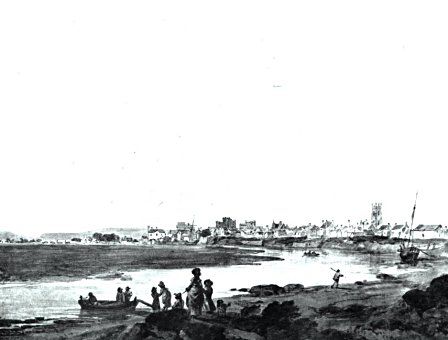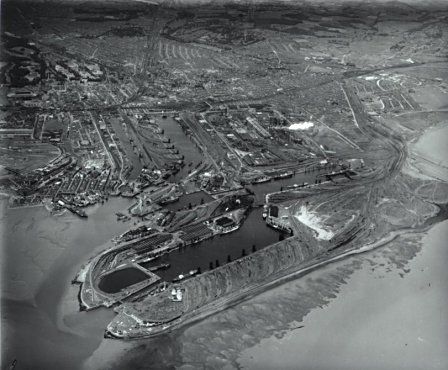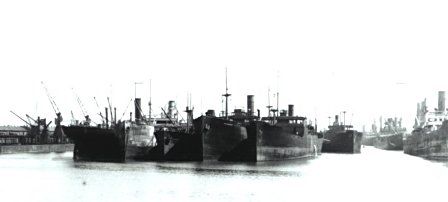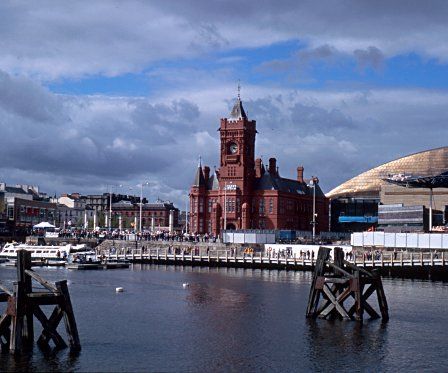Cardiff – Coal and Shipping Metropolis of the World

Cardiff: the pre-industrial port. Two sloops lying in the River Taff, as portrayed by Paul Sandby in 1776.

Cardiff: the industrial port. An aerial view showing the completed dock system about 1948.

A typical Cardiff tramp steamer - the SS Pontwen, built in 1914.

The age of depression. Laid-up ships in Cardiff docks about 1930.

Cardiff: the port transformed. Modern retail developments now stand where Cardiff once exported coal to the world.
Second Marquess of Bute
In 1862, 2 million tonnes of coal were exported from Cardiff Docks; by 1913, this had risen to nearly 11 million. This was the heyday of the coal industry before the depression of the 1930s.
Cardiff was the boom town of late Victorian Britain. For a few years before the First World War, the tonnage of cargo handled at the port outstripped that of either London or Liverpool. Yet in the late 18th century, Cardiff's trade was all transported by two small sloops sailing to Bristol on alternative days. So what had led to this transformation?
It was the growth of the iron industry in the South Wales Valleys that caused Cardiff to develop a port. In 1794, the
Glamorganshire Canal was completed, linking Cardiff with Merthyr, and in 1798 a basin was built, connecting this canal to the sea. Cardiff's foremost landowner, the 2nd Marquess of Bute, built West Bute Dock in 1839. Two years later, the Taff Vale Railway was opened.Coal overtakes Iron
From the 1850s, coal began to replace iron as the industrial foundation of south Wales. South Wales steam coal was what oil is today, with yearly exports reaching 2 million tonnes as early as 1862. A further dock, the East Bute, was opened in 1859, but following the death of the 2nd Marquess in 1848, the Bute Estate trustees were over-cautious and reluctant to invest in new dock facilities.
Coal exports reach 9 million tonnes
Frustration at the lack of development at Cardiff led to rival docks being opened at Penarth in 1865 and
Barry in 1889. These developments eventually spurred Cardiff into action, with the opening of the Roath Dock in 1887, and the Queen Alexandra Dock in 1907. By then, coal exports from Cardiff totalled nearly 9 million tonnes per annum, much of it exported by locally-owned tramp steamers.Tramp steamers and steamships
Cardiff's first steamship was the little Llandaff of 1865, and she was the first of a fleet of steamships that grew rapidly in the late 19th century. By 1910, there were some 250 tramp steamers owned at Cardiff. Each day, the owners would meet to arrange cargoes of coal for their ships in the opulent
Coal Exchange in Mount Stuart Square.The coal export industry reached its peak in 1913, when 10.7 million tonnes of coal were exported from the port.
First World War
After the First World War, there was a significant increase in shipping in Cardiff, with 122 shipping companies in business in 1920. The boom proved short-lived, however; oil was growing in importance as a maritime fuel, and the terms of the Treaty of Versailles soon flooded Europe with cheap German coal. By 1932, in the depths of the depression, coal exports had fallen to below 5 million tonnes and dozens of locally owned ships were laid-up. It was an era of depression from which Cardiff never really recovered, and despite intense activity at the port during the Second World War, coal exports continued to decline, finally ceasing altogether in 1964.
Modern day Cardiff
Today, the port of Cardiff presents a very different picture from that existing a century ago. The waterfront has been totally transformed. Exclusive flats now stand where coal hoists once stood, and the rough and ready sailortown pubs have been replaced by sedate bistros. Only two docks, the Roath and the Queen Alexandra, remain in use, and just two shipping companies remain.
There is still some trade in timber, oil, and containers, but the days when the port was packed with tramp steamers, shrouded in coal dust as they loaded the 'black diamonds' of the valleys of south Wales, will never be seen again.
Background Reading
Cardiff and the Marquesses of Bute, by John Davies. Published by University of Wales Press (1981).
Cardiff Shipowners, by J. Geraint Jenkins and David Jenkins. Published by the National Museums & Galleries of Wales (1986).
Coal Metropolis: Cardiff, 1970-1914, by Martin Daunton. Published by Leicester University Press (1977).
Comments - (6)
I have just viewed a Who Do They Think They Are programme and the story of a man by the name of Power could be that of my Uncle. Power sailed on the Sheaflance No 142706 in 1927
Where should I go to check if Thomas Fennelly sailed to Argentina on any of the coal vessels of that time.
Thank you for your enquiry.
Lists of Cardiff coal exporters can be found in local trade directories which were issued by a variety of publishers in the period you are interested in. The directories that tend to be more complete in their coverage include: “The Cardiff Year Book” by A.S.Williams & R.F.Kewer-Williams, Cardiff (ceased publication after 1933), and “The Cardiff Directory” by the Western Mail Company (not published every year). The best collections of Cardiff directories are held by Cardiff Central Library (https://www.cardiff.gov.uk/ENG/resident/Libraries-and-archives/Find-a-library/Pages/Central-Library.aspx ) and by Glamorgan Archives (https://glamarchives.gov.uk ).
I hope that this information is useful to you.
Yours sincerely,
Jennifer Protheroe-Jones
Principal Curator - Industry
Dear Keith, thank you for your comment, we have not been able to find any images of the Rydal Hall in the collections. To assist us to search for an image of a similar vessel it would be useful to know if the Rydal Hall was a ship or a barque